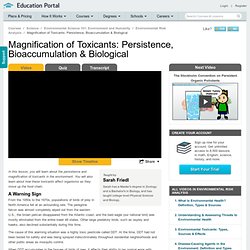

Magnification of Toxicants: Persistence, Bioaccumulation & Biological Video - Lesson and Example. A Warning Sign From the 1950s to the 1970s, populations of birds of prey in North America fell at an astounding rate.

The peregrine falcon was almost completely wiped out from the eastern U.S., the brown pelican disappeared from the Atlantic coast, and the bald eagle (our national bird) was mostly eliminated from the entire lower 48 states. Other large predatory birds, such as osprey and hawks, also declined substantially during this time. The cause of this alarming situation was a highly toxic pesticide called DDT. At the time, DDT had not been tested for safety and was being sprayed indiscriminately throughout residential neighborhoods and other public areas as mosquito control. When DDT accumulates in the tissues of birds of prey, it affects their ability to lay normal eggs with thick shells. But the birds of prey were not in direct contact with DDT, so how did it get into their tissues and cause the thin egg shells? Persistence of Toxicants Think about it this way.
Emerging Diseases Linked to Environmental Change Video - Lesson and Example. Environmental Changes and Disease Modern medicine is amazing!

Through research studies, experiments and decades of work, we have drastically reduced or even eliminated the occurrence of some dangerous human diseases. However, despite advances in technology and knowledge, some diseases are actually increasing on Earth. What's even more alarming is that this increase is due to environmental changes on Earth caused by human activities. In another lesson, we learned that the temperature on Earth is increasing at an alarming rate. Many infectious diseases, or diseases transmitted between organisms, are spread to humans through things like animals, insects, bacteria and viruses, and the environmental changes on Earth are increasing the occurrence and spread of these diseases in humans.
Changes in Water On Earth, we are increasing pools of water on a grand scale with dams, canals and irrigation for agriculture. What happens when it rains too much? Birds (and Pigs) Can Fly. There is more to closed-loop textile recycling than technological innovation. Imagine a world in which all new clothes were made from existing clothing and textiles.

Garments unsuitable for reuse would get broken down through an environmentally friendly process. Resources including polyester and cotton would be recaptured and turned back into yarn, fabric and then garments with no loss of quality. What this would mean, in the case of polyester, is that one day we will no longer need oil to produce it. Technology to make this happen exists: Swedish companies recently presented the world’s first garment made entirely from recycled cotton and should be coming to market in the coming years. These technologies represent the next generation of recycling: “closed loop” or “circular textiles” where current mechanical hurdles are overcome, including the inability to separate blended fibre garments, dyes and other contaminants.
High street brands are getting in on the act. Reuse will still be the most environmentally and economically beneficial option in future. The Story of Stuff Project. Chris Jordan - Running the Numbers. Running the Numbers looks at contemporary American culture through the austere lens of statistics.

Each image portrays a specific quantity of something: fifteen million sheets of office paper (five minutes of paper use); 106,000 aluminum cans (thirty seconds of can consumption) and so on. My hope is that images representing these quantities might have a different effect than the raw numbers alone, such as we find daily in articles and books. Statistics can feel abstract and anesthetizing, making it difficult to connect with and make meaning of 3.6 million SUV sales in one year, for example, or 2.3 million Americans in prison, or 32,000 breast augmentation surgeries in the U.S. every month. This project visually examines these vast and bizarre measures of our society, in large intricately detailed prints assembled from thousands of smaller photographs. Scorecard Home. The Fungus Among Us Could Help Clean Oily Soil. When I hear fungi, I think of mushrooms – both delectable and deadly.

But there’s another world of fungi buried in the soil. These fibrous microbes might be able to help clean up polluted soil. I’ve always thought of bacteria as nature’s decontamination crew. Bacteria already munching on oil from natural seeps in the Gulf of Mexico flourished after the 2010 Macondo well blowout in the Gulf of Mexico. Several different groups of microbes ate their way through much of the hydrocarbons in the oil within a few months of the well being capped. Oil-eating bacteria live in the soil too, but they have a harder time reaching food than their aquatic relatives.
Fungi sprout thin shoots called hyphae as they grow through the soil. Lukas Wick, of the Helmholtz Center for the Environment in Germany, and his colleagues think fungi might be able to help clean up contaminated soil. Fungi have another green cleaning benefit hidden in their structure. Related Category: Biology, Blog, Chemistry.